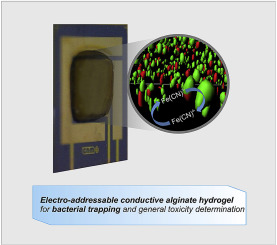当前位置:
X-MOL 学术
›
Anal. Chim. Acta
›
论文详情
Our official English website, www.x-mol.net, welcomes your
feedback! (Note: you will need to create a separate account there.)
Electro-addressable conductive alginate hydrogel for bacterial trapping and general toxicity determination
Analytica Chimica Acta ( IF 5.7 ) Pub Date : 2018-12-01 , DOI: 10.1016/j.aca.2018.06.062 N. Vigués , F. Pujol-Vila , A. Marquez-Maqueda , X. Muñoz-Berbel , J. Mas
Analytica Chimica Acta ( IF 5.7 ) Pub Date : 2018-12-01 , DOI: 10.1016/j.aca.2018.06.062 N. Vigués , F. Pujol-Vila , A. Marquez-Maqueda , X. Muñoz-Berbel , J. Mas

|
In biosensors development, alginate hydrogels are a first choice for enabling stable biomolecules entrapment in biocompatible membranes obtained under soft physiological conditions. Although widely exploited, most alginate membranes are isolating and poorly repetitive, which limit their application in biosensing. Significant steps forward on improving repeatability and conductivity have been performed, but to date there is no single protocol for controlled deposition of live cells in replicable conductive alginate layers. Here, cell electrotrapping in conductive alginate hydrogels is examined in order to overcome these limitations. Conductive alginate-coated electrodes are obtained after potentiostatic electrodeposition of graphite-doped alginate samples (up to 4% graphite). The presence of graphite reduces electrode passivation and improves the electrochemical response of the sensor, although still significantly lower than that recorded with the naked electrode. Bacterial electrotrapping in the conductive matrix is highly efficient (4.4 × 107 cells per gel) and repetitive (CV < 0.5%), and does not compromise bacterial integrity or activity (cell viability = 56%). Biosensing based on ferricyanide respirometry yielded a four times increase in biosensor response with respect to non-conductive alginate membrane, providing toxicity values completely comparable to those reported. Cell electrotrapping in conductive hydrogels represents a step forward towards in high-sensitive cell-based biosensors development with important influence in environmental analysis, food and beverage industry as well as clinical diagnosis.
中文翻译:

用于细菌捕获和一般毒性测定的电寻址导电藻酸盐水凝胶
在生物传感器开发中,藻酸盐水凝胶是在软生理条件下获得的生物相容性膜中稳定生物分子捕获的首选。尽管被广泛利用,但大多数海藻酸盐膜是隔离的且重复性差,这限制了它们在生物传感中的应用。在提高可重复性和电导率方面取得了重大进展,但迄今为止,还没有单一的协议来控制可复制导电藻酸盐层中活细胞的沉积。在这里,为了克服这些限制,研究了导电藻酸盐水凝胶中的细胞电捕获。在对掺杂石墨的海藻酸盐样品(高达 4% 的石墨)进行恒电位电沉积后获得导电海藻酸盐涂层电极。石墨的存在减少了电极钝化并改善了传感器的电化学响应,尽管仍显着低于裸电极记录的响应。导电基质中的细菌电捕获效率高(每个凝胶 4.4 × 107 个细胞)和重复性(CV < 0.5%),并且不会损害细菌的完整性或活性(细胞活力 = 56%)。相对于非导电藻酸盐膜,基于铁氰化物呼吸测定法的生物传感使生物传感器响应增加了四倍,提供的毒性值与报道的完全相当。导电水凝胶中的细胞电捕获代表了向高灵敏度细胞生物传感器发展迈出的一步,对环境分析、食品和饮料行业以及临床诊断具有重要影响。
更新日期:2018-12-01
中文翻译:

用于细菌捕获和一般毒性测定的电寻址导电藻酸盐水凝胶
在生物传感器开发中,藻酸盐水凝胶是在软生理条件下获得的生物相容性膜中稳定生物分子捕获的首选。尽管被广泛利用,但大多数海藻酸盐膜是隔离的且重复性差,这限制了它们在生物传感中的应用。在提高可重复性和电导率方面取得了重大进展,但迄今为止,还没有单一的协议来控制可复制导电藻酸盐层中活细胞的沉积。在这里,为了克服这些限制,研究了导电藻酸盐水凝胶中的细胞电捕获。在对掺杂石墨的海藻酸盐样品(高达 4% 的石墨)进行恒电位电沉积后获得导电海藻酸盐涂层电极。石墨的存在减少了电极钝化并改善了传感器的电化学响应,尽管仍显着低于裸电极记录的响应。导电基质中的细菌电捕获效率高(每个凝胶 4.4 × 107 个细胞)和重复性(CV < 0.5%),并且不会损害细菌的完整性或活性(细胞活力 = 56%)。相对于非导电藻酸盐膜,基于铁氰化物呼吸测定法的生物传感使生物传感器响应增加了四倍,提供的毒性值与报道的完全相当。导电水凝胶中的细胞电捕获代表了向高灵敏度细胞生物传感器发展迈出的一步,对环境分析、食品和饮料行业以及临床诊断具有重要影响。











































 京公网安备 11010802027423号
京公网安备 11010802027423号